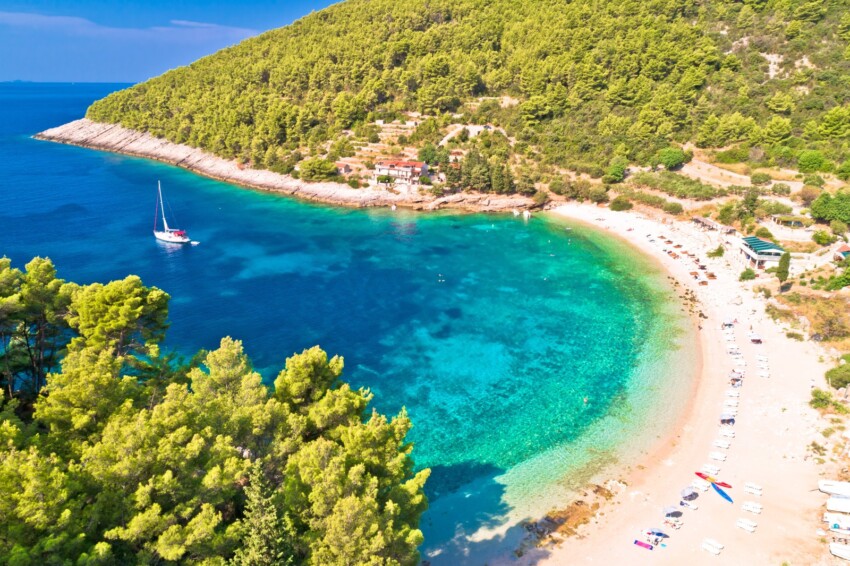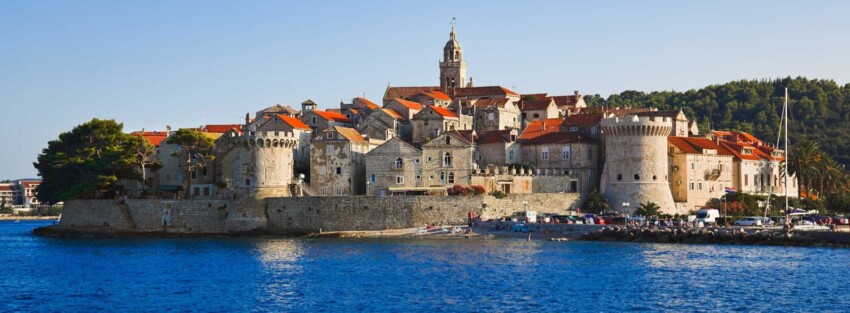

47 km long but only 5 km wide, the island of Korčula ensures that at any given time you will never be far from the sea.
There are numerous beaches, bays, coves and inlets dotting the coastline, but during your holiday in Korčula take some time to visit the villages and hinterland. It is an island rich in history and folklore. The most spectacular tradition is undoubtedly the sword dance, which has been handed down for centuries and is now performed on several occasions to the delight of tourists.
The landscape is dominated by dense forests, but there is also plenty of room for expanses of vineyards and olive groves. Interesting are the white wines produced on the island, which is attracting an increasing number of food and wine tourism travellers.
So what if you are not a wine expert? You can sip a nice glass of fresh white during your dinner: what could be better after a sunny day at the beach?
One of the island’s most famous tourist attractions is the alleged birthplace of Marco Polo. There is no definite proof that he was born here, but it is certain that Korčula will remain in the hearts of all travellers.

A typical example of a medieval Dalmatian town, beautiful Korčula sits on a small hill that juts out into the sea. It is a quiet place and the centre is pleasant to visit, with its red-roofed stone houses and palm trees providing some coolness.
A city rich in history, it still retains an impressive defensive system of walls and towers. Enter the old town through the Veliki Revelin tower, decorated with the coats of arms of the Doges of Venice and the Dukes of Korčula, then take a look at the Western Sea Gate Tower, the Great Governor’s Tower and the Small Governor’s Tower.
During your walk through the centre, pay attention to the layout of the streets, which when seen on a map resemble a fishbone.
The urban layout of Korčula is not random; on the contrary, it has been carefully designed to ensure the safety and well-being of the inhabitants, opening the town to the mistral, a summer wind that brings coolness, and limiting the impact of the bura wind in winter.

Just a 10-minute bus ride from the main town is this pretty fishing village, which has become a popular tourist destination thanks to the beaches in its surroundings, the only sandy beaches on the island. Surrounded by vineyards, Lumbarda is famous for the production of a particular white wine with an almost unpronounceable name: ‘grk’.

Accessible from the old town of Korcula with a 20-minute walk (or, if you’re lazy, a five-minute bus ride), the village of Zrnovo is famous for its ancient cypress trees, terraced hillsides planted with vines, bell towers and olive trees. Footpaths lead from here to enchanting bays on the southern part of the island.
A small village of 500 inhabitants, mostly all fishermen and their families, situated on a bay in the north of the island.

The oldest settlement on the island dates back to the Illyrians and still retains an old-world charm, although most tourists come here for the beautiful beach at Pupnatska Luka.
Situated in the centre of the island, Cara and Smokvica are two important destinations for wine tourists: two famous Croatian white wines, Posip and Rukatac, are produced here.
Blato (or Blatto) is one of the largest towns on the island, famous for olive oil production and sword dancing.

Situated on a wide bay that gives the town its name (in Croatian, vela means large and luka bay), Vela Luka is the westernmost settlement on the island and the main fishing centre. The village is overlooked by a very large cave, which can be reached on foot from the centre and can be visited. There are few beaches in the surroundings.
The favourite destination for locals for a Sunday outing is the small island of Vrnik, easily reached by water taxi from the port of Korcula.
Korčula boasts a wide variety of beaches washed by the clear, colourful sea.
You can choose between beaches that are easy to reach, with all amenities, or more remote and secluded beaches for more privacy and tranquillity. Many are pebbly, but there is no shortage of sandy beaches.
Here are three beaches not to be missed during a holiday in Korčula.
The most popular beach on the island, frequented by tourists and locals alike, is the sandy Vela Przina near Lumbarda in the southern part of the island. It fills up with people in the summer, so it is advisable to arrive early in the morning.
You can get there comfortably by car, but there is a charge for parking on the beach, or by bus from the town of Korčula (about 15 minutes). There are two bars and restaurants on the beach and a beach volleyball court.

The enchanting bay of Pupnataska Luka is undoubtedly one of the most beautiful on the island. The small pebble beach is really pretty and the sea is of an extraordinary colour.
Dense pine forests surround the bay, but there is no natural shade on the beach, so if you plan to spend the whole day here, take a parasol with you or rent one.
There are a couple of bars and restaurants, while there are no grocery shops nearby.
Another attractive bay, a favourite destination for those who love swimming, is Bačva Bay, south of Žrnovo, where a beautiful pebble beach opens up. The path to it is challenging and many people prefer to arrive here by boat and dive straight into the clear emerald green waters.
There is a kiosk on the beach selling food and drinks, including excellent grilled fish.
In the following map you can see the location of the main places of interest mentioned in this article.

There are many options as to where to stay in Korčula, but the choice essentially depends on the type of holiday you want to take, and where you arrive on the island. Coming from Split, you will most likely dock in Vela Luka, the easternmost town on the island. After a boat trip of about three hours you might want to rest as soon as possible, so finding accommodation in this area might prove to be the right choice. And it certainly won’t be difficult, given the abundance of flats and hotels in and around the town.
Korčula is criss-crossed along its entire length by road 108, which runs mostly inland. This is where most of the island’s settlements are located, such as Blato na Korčuli, Smokvica, Čara and Pupnat . In these villages you will mostly find rented flats or small holiday homes, but with two big advantages: first of all, they are less expensive areas, and secondly, staying in the interior will allow you to be in the geographical centre of the island, ideal for exploring it far and wide.
Finally, on the north-east coast of Korčula are two of the most important tourist centres on the island: Korčula Town and Lumbarda. The former is also the largest town on the island, with around 6,000 residents, which obviously rise by several tens of thousands in the summer. Here you will find all the amenities and a myriad of accommodation to stay in. The second is more secluded and reserved, dedicated to quieter tourists such as couples or families with children.

But is Marco Polo really Venetian? According to the Croats, no, he was born in Korčula, and to prove it to you, they take you on a tour of his (alleged) birthplace in the old town centre, which has been turned into a small museum dedicated to the famous adventurer’s great journeys.
Whether he was really born in Korčula or not, the locals really seem to love Marco Polo, organising celebrations and events in his honour.
Perhaps it is simply a shrewd tourist marketing operation, but if you love travelling, a look at this museum is worth it, as a tribute to one of the symbols of the irrepressible human desire to travel.
The traditional spectacle on the island of Korčula is the atmospheric sword dance. Of Spanish origin, it is now only performed here and has been a tradition on the island since the 15th century.
Picturesque and original, it enacts the story of two kings, the white king and the black king, who fight over a princess, in love with the former but kidnapped by the latter. Don’t look for a king dressed in white on stage because the character of the white king wears red!
Other popular traditional festivities are those related to Holy Week, with solemn processions and ceremonies organised by local brotherhoods.
To reach the island of Korčula from mainland Croatia you can take a ferry from the cities of Rijeka, Split and Dubrovnik.
There are direct buses connecting the island with the cities of Zagreb and Dubrovnik.
What's the weather at Korcula? Below are the temperatures and the weather forecast at Korcula for the next few days.
Theisland of Korčula is located in Dalmatia, the southernmost region of Croatia. It is situated off the Peljesac peninsula, from which, at its closest point, it is less than 500 metres away.
It is elongated in an east-west direction, about 40 kilometres long and only 5 kilometres wide. Korčula is quite distant from the surrounding islands: the nearest is Mljet, which is about 15 kilometres southeast of its tip.
The nearest Italian town to Korčula as the crow flies is Peschici, in the province of Foggia, some 120 kilometres away, but the island is at the same latitude as San Benedetto del Tronto, in the Marche region, some 220 kilometres away.